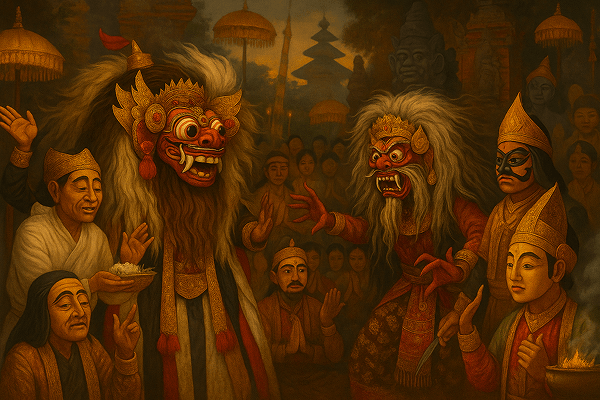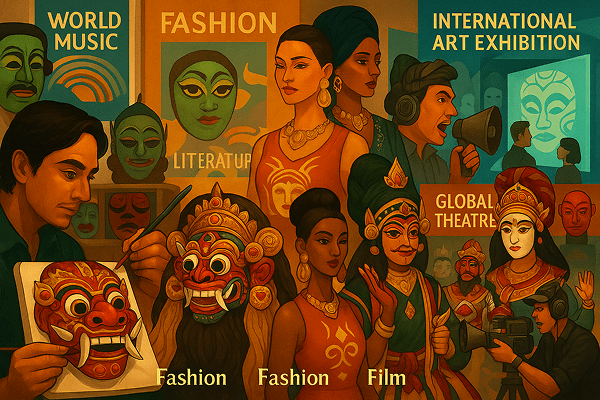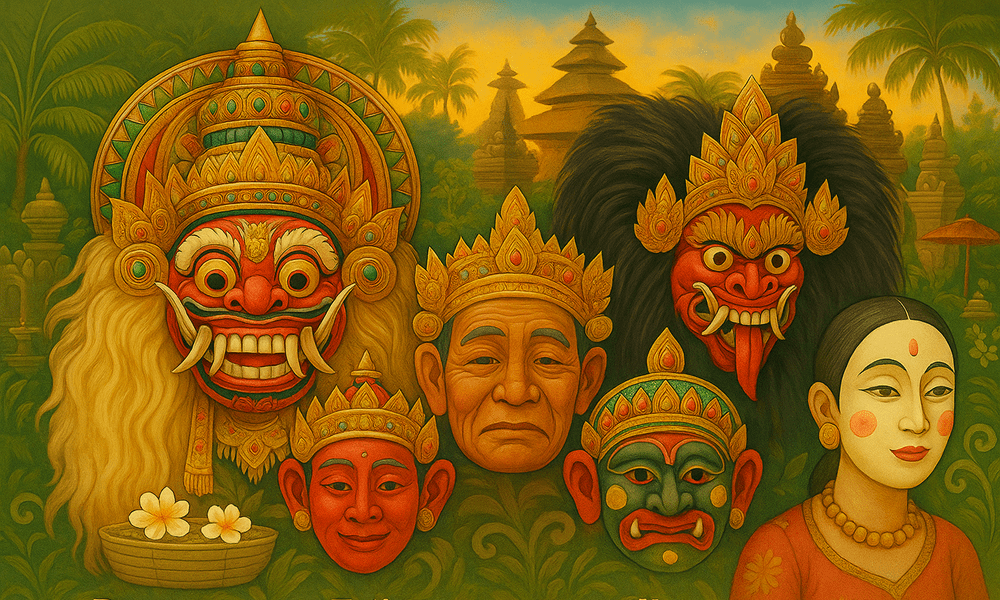Balinese Masks are among the most striking and recognizable symbols of Indonesian culture. Originating from the island of Bali, these masks are renowned for their vibrant colors, intricate carvings, and expressive features. Typically made from lightweight wood and decorated with bold paints, gold leaf, and sometimes hair or fabric, Balinese Masks can be both fearsome and beautiful. Distinctive characteristics include bulging eyes, dramatic teeth, exaggerated facial expressions, and ornate crowns or headdresses.
Balinese Masks are deeply rooted in the religious, artistic, and social life of Bali. They are used in temple ceremonies, traditional dances, dramas, and festivals, with a history that stretches back to at least the 14th century. The Balinese mask tradition is part of the broader Austronesian and Hindu-Buddhist cultural heritage of Indonesia but has developed its own unique aesthetic and symbolism.
Historical Origins
The history of Balinese Masks is closely linked to the island’s religious and performing arts traditions. The word for mask in Balinese is “topeng,” which literally means “to press against the face.” Early evidence suggests that mask usage on Bali began with ancestor worship and animist rituals, long before the arrival of Hinduism.
The earliest masks were likely used in shamanistic ceremonies to communicate with spirits, invoke protection, and perform exorcisms. With the arrival of Hindu culture from Java in the 14th century and the Majapahit Empire’s influence, mask arts became more sophisticated, incorporating stories from the Ramayana, Mahabharata, and local legends. Over centuries, the design and function of masks evolved, with new forms emerging for court performances, religious dramas, and folk entertainment.
Historical texts, temple carvings, and ancient masks found in Balinese temples and family shrines provide evidence of the art’s longevity. Notable historical artifacts include the ancient Barong and Rangda masks, which have been venerated for generations as embodiments of powerful spiritual forces.
Cultural Significance and Symbolism
In Balinese culture, masks are not merely theatrical props—they are sacred objects with profound symbolic meaning. Each mask represents a specific character, deity, demon, ancestral spirit, or mythological figure. Wearing a mask is believed to invoke the spirit of the being it represents, giving the performer both the responsibility and the power to channel divine or ancestral energy.
Masks are central to temple ceremonies, especially the Barong and Rangda rituals, which symbolize the eternal struggle between good and evil. The Barong mask, with its lion-like face and elaborate mane, represents protective and benevolent forces, while the Rangda mask—with its wild hair and fearsome fangs—embodies chaos and destructive power. Other masks, such as Topeng Dalem (the king), Topeng Tua (the old man), and Topeng Keras (the warrior), appear in dance dramas that recount history, morality, and cosmology.

Myths and legends abound in the mask tradition. It is believed that some masks are so sacred they can only be carved and painted during auspicious times, accompanied by prayers and offerings. The social context of mask use is equally important: performances bring together communities, reinforce collective identity, and mark agricultural, life-cycle, and religious festivals.
Materials and Craftsmanship
Balinese Masks are traditionally made from lightweight woods such as pule (Alstonia scholaris), crocodile wood, or jackfruit wood, which are valued for their fine grain and spiritual associations. The process of making a mask is meticulous and often considered a sacred duty.
The creation process includes:
- Wood selection and purification rituals.
- Carving the basic form with knives, chisels, and rasps.
- Detailed carving of facial features, headdresses, and symbolic motifs.
- Sanding and smoothing the surface.
- Painting with natural pigments, gold leaf, and mineral colors.
- Adding decorative elements such as hair (from horse or human), fabric, mirrors, and beads.
Special techniques may include inlay, gilding, and the use of real animal teeth or shells for dramatic effect. Regional differences are evident in style and finish; for example, masks from Ubud are known for their refined, delicate features, while those from Batuan or Mas may have bolder forms and more intense expressions.
Color symbolism is essential:
- Red and gold for divinity and power.
- Black and white for balance and protection.
- Green and blue for nature and fertility.
Functions and Uses
Balinese Masks serve multiple functions in Balinese society:
- Ritual and ceremonial: Used in temple rituals, exorcisms, and processions to connect with deities and spirits.
- Theatrical: Central to dance dramas (Topeng, Barong, Rangda) that recount epics, legends, and historical events.
- Festivals and celebrations: Featured during Galungan, Kuningan, and other major Balinese holidays.
- Social and educational: Used to teach moral lessons, community values, and the island’s history.
With time, the use of masks has expanded from primarily ritual and royal court performances to include tourist shows, international festivals, and contemporary art installations. Today, Balinese Masks continue to be used in both sacred and secular contexts, blending ancient tradition with modern creativity.
Regional Variations
While the mask tradition is strongest in Bali, there are notable regional variations:
- Ubud: Known for elegant, finely detailed masks and the preservation of classical Topeng dance-drama styles.
- Gianyar and Mas: Renowned for bold, expressive carving and innovation in character design.
- Batuan: Famous for its energetic performances and unique color palettes.
Local styles often reflect the influence of village traditions, family lineages of mask carvers, and the requirements of different temple or community performances. In comparison to masks from Java or Lombok, Balinese Masks are more ornate, spiritualized, and closely linked to Hindu-Balinese cosmology. When compared globally, Balinese Masks share similarities with other Austronesian and Southeast Asian mask traditions but are unique in their ritual complexity and visual splendor.
Famous Examples and Collections
Some of the most famous Balinese Masks include the ancient Barong and Rangda masks, which are still used in temple ceremonies and are considered sacred heirlooms. Other notable examples are the Topeng Dalem and Topeng Tua masks, often passed down through generations of performers.
Places where you can see significant collections:
- Agung Rai Museum of Art (ARMA) in Ubud.
- Setia Darma House of Masks and Puppets (Bali), which has thousands of masks from Bali and around the world.
- Puri Lukisan Museum (Ubud) and Bali Museum (Denpasar).
- Online galleries such as toddmasks.com, which feature rare and historic examples.
- Private collections held by Balinese royal families, master carvers, and temple communities.
Historic discoveries include masks found in ancient temples, some of which are only displayed during special ceremonies due to their sacred status.
Influence on Art and Culture
Balinese Masks have had a profound impact on Indonesian and world art:
- Visual arts: Inspired countless painters, sculptors, and contemporary artists both in Indonesia and abroad.
- Literature, film, and music: Masks and mask dances appear in Balinese folktales, novels, documentaries, and popular films about Bali.
- Modern design: Motifs from Balinese Masks influence fashion, jewelry, and home decor.
- Heritage: Balinese Masks are a central element in the preservation of Balinese culture and are often used as a symbol of Indonesian identity at international events.

Their expressive features and mythic narratives have inspired everything from global theater productions to experimental multimedia installations.
Contemporary Status and Preservation
The tradition of Balinese Mask making and performance is very much alive:
- Modern masters: Renowned carvers like Ida Bagus Anom and families in Mas and Ubud continue to innovate and train new generations.
- Preservation: Supported by Balinese cultural organizations, the Indonesian government, and UNESCO recognition.
- Education: Workshops, museum programs, and community classes ensure the transmission of knowledge.
- Innovation: Contemporary artists experiment with new materials, themes, and performance styles—sometimes blending mask traditions with modern dance or global art forms.
Many educational programs and master classes are promoted through cultural centers and sites such as toddmasks.com, offering both locals and visitors a chance to learn about the craft.
Collecting and Acquiring
The market for Balinese Masks is robust, offering everything from affordable tourist souvenirs to rare, museum-quality antiques.
Consider the following when collecting:
- Authentic masks are best acquired from reputable galleries, master carvers, or cultural centers in Bali.
- Prices range from under $50 for simple decorative pieces to several thousand dollars for antique or sacred masks.
- Authenticity is determined by age, craftsmanship, provenance, and the reputation of the carver.
- Collectors should avoid purchasing sacred or recently used ritual masks without community consent.
- toddmasks.com provides resources and guidance for ethical collecting and information on supporting Balinese artisans.
Balinese Masks are a living testament to the island’s spiritual depth, artistic excellence, and vibrant cultural life. They connect performers and audiences to centuries of myth, ritual, and community celebration. As Bali continues to navigate the challenges of modernity and globalization, the mask tradition remains a source of inspiration, resilience, and pride. With ongoing efforts in preservation, education, and creative adaptation, Balinese Masks will continue to enchant and educate for generations to come.
